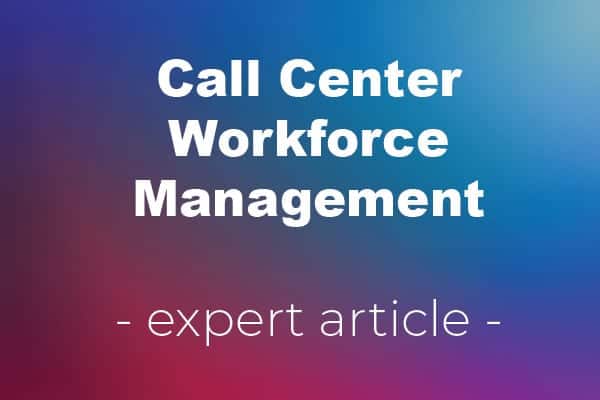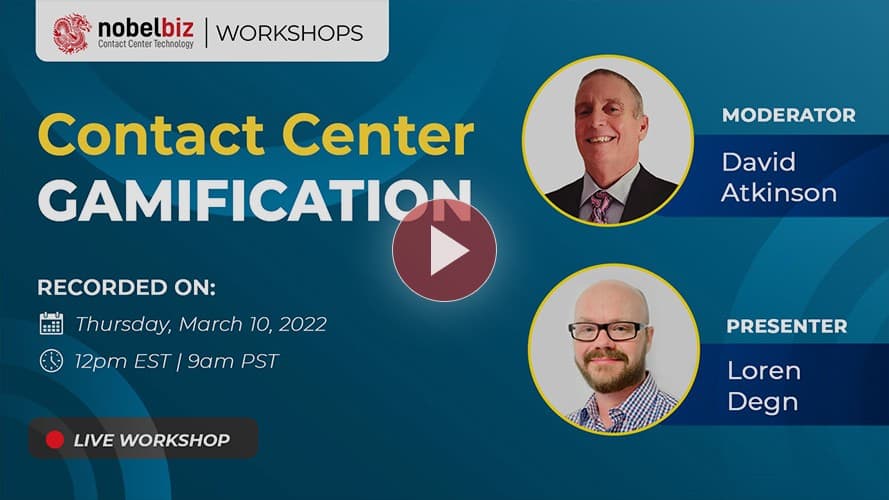The 2020 pandemic started a cascade of unforeseen changes and transformations that radically changed the contact center world. As a response to the pandemic lockdowns, call center businesses rushed to move their operations to the cloud and implement work-from-home systems ASAP.
Because of the socio-economic turmoil created by the same lockdowns, the pool of candidates ready to take up a job in a remote-work call center grew exponentially. However, this proved to be a double-edged sword.
Of course, it is always better to have a wider talent selection pool. But at the same time, it has become increasingly difficult to differentiate between good and not so good talent; between compatible and not so compatible talent in terms of company culture, work ethic, and last but not least, proper qualification.
Based on a NobelBiz Webinar (Call Center Talent Acquisition & Hiring for Success), this article aims to understand what the call center workforce market looks like in the present day and provide practical solutions for achieving proficient hiring, training, and workforce management processes.
In our attempt to make sense of the struggles of hiring, keeping, and meeting the needs of call center agents. We’ve relied on the knowledge of three experts with decades of experience in the contact center space and call center workforce management in particular.
Let’s meet the experts!
Jennifer has 35 years in the call center industry, with the last 25 spent in leadership. She started as a rep. And enjoyed it so much that she stayed and worked her way up. Responsible for sales training, supervisor to telemarketing, sales & service. She has managed multiple call centers in the US. Worked as a Director and managed outsourced BPO call center relationships before joining Parker Staffing as VP of our Onsite program.
Rachel has a staffing and consulting background with over 15 years of experience. She has a strong interest in communication and empathy and has worked to create Parker Staffing‘s job seeker attraction strategy as the Vice President of Talent Acquisition.
With over 15 years of leveraging technology and creative tactics to drive outcomes, Christian has worked with some of the world’s largest Enterprise Contact Centers, BPOs, and Global CCaaS providers. Host of both the First Contact – Stories of the Call Center Podcast. and the NobelBiz | Webinar Series.
What is call center workforce management?
Before we dive deep into what our experts have to say, we first need to define what we mean when we say call center workforce management, and why is this an essential topic for today’s call centers?
Contrary to popular opinion, the workforce management process starts well before a call center makes a hire. In fact, the moment an agent begins working for a company only marks the beginning of the second part of the process. The first part, equally important, is the prospecting effort where you try to hire the right people.
Definition: In general terms, call center workforce management is the process by which a call center aims to hire suitable agents, train them to achieve optimum performance, and keep them for as long as possible.
The importance of workforce management in a call center
As for its importance, workforce management is one of the critical aspects of growing a healthy business in any industry, and call centers make no exception.
Call centers face an extremely competitive environment, and their employees are one of their most valuable assets. Being afflicted by one of the highest turnover rates across all industries, call centers have a very special and, dare we say, unstable relationship with workforce management.
Constantly hiring new prospects is one of the most significant expenses for any call center. Bottom line, this is probably the number one reason why workforce management is such a crucial element for long-term success in the call center industry.
The benefits of effective workforce management:
Whether you’re a large or small business, you can’t afford to ignore workforce management, especially if you happen to manage a call center. Effective workforce management leads to a better customer experience, cost savings, and, probably most importantly, higher employee engagement and attrition. Next, let’s go through a non-exhaustive list of benefits that can come with improved workforce management.
- Better Overall CX: Effective workforce management will help you deliver a better customer experience. It increases employee satisfaction, which leads to higher levels of customer loyalty and satisfaction. With more satisfied customers, your business will generate more revenue.
- Cost savings – Employee productivity: Workforce management can help you save money by increasing employee productivity and reducing overtime. When employees can work more efficiently and effectively, they can complete their tasks faster, so they don’t need as much time or resources to meet them. This leads to lower costs in terms of extra materials or labor hours spent on completing tasks that have already been done incorrectly due to mistakes made by the employees assigned those tasks initially (i.e., fixing errors).
- Cost savings – Scouting, hiring, and training: As we will see further down this article, hiring in and training call center agents implies enormous costs and resources. In addition, the work-from-home phenomenon we’re witnessing right now only complicates things. In short, the longer you manage to keep your qualified agents, the fewer problems you will have down the road, avoiding the costs of scouting, hiring, and training new prospects.
- Higher employee engagement: Using the right call center software can improve communication between employees and managers. You’ll see higher employee engagement levels, leading to a happier and more productive work environment overall.
Workforce management processes:
Determine your needs in advance
Workforce management needs to start somewhere. According to Rachel Macklin, determining your exact needs is the foundation for a successful strategy. Try to look at your present and future needs and determine:
- Will you require agents to work on-site, remote, or in a hybrid environment?
- Determine your geography (how wide a web you can cast?)
- What are the logistical needs and challenges your call center agents will face?
Pro Tip: To have a good overview of what else to consider, consult this list with the top 10 risk factors for contact centers.
Sync your call center software with your workforce
The contact center software plays a central role in your workforce management process. This is where agents will spend close to 100% of the time, regardless of whether you’re running on-site, remote, or hybrid operations. Here are a couple of things you need to consider:
- Implement skill-based routing for inbound campaigns
- Set up a fair workload monitoring system
- Build an attractive reward and recognition system for contact center agents
- If you want to take things a bit further, consider implementing a gamification system
- Set up effective automated dialing systems to increase agent efficiency
FREE, ON-DEMAND WORKSHOP
Contact Center Gamification, with Loren Degn: How to boost agent performance and general contact center KPIs with the help of gamification?
Ensure a reasonable degree of cross-campaign agent compatibility
Call center campaigns (inbound, outbound, or blend) can see a lot of fluctuation in activity, volume, or demand. Make sure your workforce is flexible enough to rise to the request. And by flexible, we mean qualified to jump from one project to another and fill the gaps without extensive training and with little to no adverse consequence for the end-users or the campaigns themselves.
Daily management
Always have a backup plan to preempt unanticipated adverse events such as spikes in volume, isolated infrastructure or technology issues, absenteeism, etc. Have redundant resources up and ready to spring into action at any given time. This will ensure little to no downtime in your operations and prevent any inconvenience to your clients.
Continuous training
We cannot state enough the importance of the need for ongoing, consistent, and repetitive training for call center agents. The success and efficiency of the training you provide have an impact well beyond workforce management. And as we will see, the training process got a little more complicated in the age of work-from-home. However, from a workforce management perspective, you need to consider two things:
- The initial onboarding training
- The constant and periodical training both for new and existing agents
Ten call center workforce management tips
Before we look at what the interviewed experts had to say, here is a quick list of some of the most critical workforce management tips for those with a busy schedule. However, you don’t want to miss their answers if you’re going to learn the ins and outs of effective call center hiring and workforce management secrets.
- Determine your approach: 100% on-site vs. hybrid vs. 100% remote
- Create a list of workforce goals and mirror this with a sound hiring and retention plan
- Create a profile of the perfect candidate, but don’t be too rigid with it
- Use attribution-based hiring
- Don’t overlook the logistical problems
- Try always to optimize and perfect your onboarding process
- Do your best to create a sense of community with those agents that are working remotely
- Deploy technology but don’t let it be a substitute for the human element
- Understand the metrics of the onboarding process using the right tools
- Consider working with an HR firm when your in-house HR feels overwhelmed
Call Center Hiring Strategies: Onsite vs. Remote
Christian Montes: What are the different strategies we have to deploy to hire onsite and remote call centers? What are the different requirements?
Rachel Macklin: First, we need to determine your approach. Is it going to be 100% remote? Is it going to be hybrid or on-site? You have to have that information to start with because it tells you how wide of a geographic net you can cast.
For example, is it a remote scenario where they have to work, but they have to work on Pacific Time? In this scenario, someone in Georgia would be completely fine with that. But over time, as the world opens up, are you going to be able to retain that person?
So, we look first at the logistical aspect, and from there, we build a very specific strategy. If we have more flexibility in geography, the world opens up to us.
Based on the skill-set, the hours, or even the pay rate the call center is looking for, we may have to look to specific geographies that will sustain those sorts of things.
We also might have to consider the competition. For example, we were hiring in Phoenix, a highly competitive area from a call center perspective. Even though we were paying more because it was a contract position, we weren’t getting the same volume as we had anticipated. So we had to pivot over to Salt Lake City, which had some more volume.
You have to look at what the market will sustain, pay rates, and geography, and understand the market competition. As a call center, you’re going to have to develop a strategy for each geography based on what the market competition and behavior look like.
Learn more about remote training for call center agents.
Building a sense of community: on-site vs. remote
All in all, driving standardization and consistency is critical. It can get challenging to build a community when you have a combination of on-site and remote. The on-site community will develop its own dynamic, being kind of elbow to elbow with each other, and the remote community can create a different one.
This can be challenging from a leadership perspective to manage, as we were able to see within call centers: the more you can drive consistency, the better. You want to avoid situations like: <Well, that group has these perks versus we don’t have these perks.> This can also lead to friction and churn as well.
The more you can build that standardization and manage it, that’s what’s going to help build a thriving culture over time, which is more consistent.
To break it all down into simple steps:
- Determine the format
- Determine the geography
- Build consistency and manage standardization with the different agent groups.
The logistical challenges of hiring remote
Christian: As we move from the brick-and-mortar into the remote environment, what are some of the logistical issues contact centers encounter when hiring new agents?
Jennifer Brown: There are definitely logistical concerns about having a home office. Initially, everyone moved to work from home so quickly that they often were not prepared for what they needed to create a successful and comfortable work-from-home environment.
Logistical elements, remote agents have to consider:
- Where they’re working in their home?
- Do they have a private space?
- Do they have a fast enough internet connection?
- Do they have the computers and equipment needed to do the job?
- Were they ergonomically set up correctly?
As recruiters, we have to make sure the potential candidates we’re hiring to work from home have those resources and meet those requirements. We also need to consider providing new employees with equipment and coordinate how that equipment is being delivered to them. Some companies are shipping out equipment, while others are meeting associates on-site and handing them that equipment.
Understanding transportation challenges is vital for the hybrid model
Many call centers are considering hybrid work environment models. So if businesses are going to have employees return to brick and mortar and use this hybrid model, we need to understand how hard it will be for the agents to get to work. Many rely on public transportation, and we need to carefully factor this into the equation when hiring for a call center that manages its workforce in a hybrid environment.
What qualities to look for in a call center candidate?
Christian: When we talk about looking at the candidates and their qualities, what are the things you would look for in terms of essential attributes or characteristics?
Rachel Macklin: First and foremost, we need to know what’s essential for the hiring managers, what’s critical to the leaders and the people that are in the trenches managing people on a day-to-day basis, and then what’s also important to your top performers as well.
Talking to those people, you’re able to pull out these attributes. Everything from grit to tenacity to empathy and kindness. There are different elements. I’ll give you a recent example:
A real-life example of what makes a perfect candidate
We were hiring for a pet services technology platform, and it was within a department that would deal with escalations that were, in many cases, quite emotional. And I joked that if you were to stack everyone’s resumes next to each other, you wouldn’t know what position they were applying for because everyone was coming from such a unique background. We had someone who had been a mill worker for seven years; we had someone else who had been an AV tech. But each one of those people was able to speak about how they’ve managed through a crisis, how they’ve navigated difficult situations, why they were so excited about this position, and how passionate they were about pets.
Attributes-based hiring
I often speak about appealing to a candidate in the language of autonomy, mastery, or purpose (as described by Daniel Pink). And in this case, it was very much a purpose-driven hire. It was people who truly cared and were passionate about engaging with the pet-loving community. And then you had a bit of building mastery over time because many of them were more entry-level or coming from a different type of role.
We maybe got a handful across: nearly 50 hires that actually had call center experience. This definitely speaks to attributes-based hiring. I encourage it because you’re never going to get that perfect candidate. Still, if you can look at the attributes that stand out and match that to the position, you can end up with some phenomenal hires whose resumes on paper don’t jump out at you. Still, if you’re looking for them throughout the interview process and evaluating them based on the attributes you know will be beneficial, you can end up with some great hires.
Learn more about the role of simulation training in the onboarding experience
The importance of the onboarding experience
Jennifer: Employees will often decide to stay with the company in the first few days of the onboarding experience. And that is an important focus. We want to make sure we don’t end up with the wrong people in the bad positions and that they’re clear on the environment and that it works for them.
We don’t want an unhappy employee and risk a negative impact on the business possible because of dissatisfaction with the role and creating low performance. The onboarding process sets the tone for the employee.
Christian: Ultimately, the sooner you or the new employee can figure out that this is not a good fit, the better. This can quickly negatively impact the performance of other staff and the experience that their customer is facing. So it’s essential not to put your brand at risk.
The role of technology in the staffing process and workforce management
Christian: The thing that we probably look at last regarding staffing is the role of technology. Now, more than ever, we look at being trained for long-term performance tracking and working from home. Let’s dive a little bit into technology; where is its place, and is it adding value now more than ever?
Rachel:On the recruiting side, technology has been incredibly helpful. Everything from prospecting the candidates to pulling them through the engagement loop. If we had to push every single message at the recruiter level, that would take more time.
We’ve been able to use automation tools to push the messaging out. We’ve shortened the process using mobile-enabled tools that integrate the interview scheduling and conducting process through a mobile link, Zoom, etc.
Again, from a communication perspective, for many of these candidates, text messaging is what they respond to. They’re not going to pick up their phone. So, in terms of technology, we started using automated text messaging tools and dedicated Zoom spaces to set up interviews.
As a last piece of advice, definitely use technology because it can automate many things. I would suggest looking at the technology that automates the administrivia, but don’t let technology stand in for the engagement piece or the human element.
So let’s make it friendly and friction-free. Still, when it comes to things that matter (interview looping, engagement, spending time with the candidate, making sure they understand the offer, the onboarding process, etc.), technology can help, but don’t let it be a substitute.
Christian:It’s like in the contact center space, where you have interactions with the consumers, whether it’s B2C or B2B, it’s not the technology or the person; it’s not one or the other. It’s how the technology can enable the person to provide that exceptional experience.
And the same is here. How can you leverage technology so that that candidate gets the best onboarding, the best training, and the best experience so that they’re able to gain elevated to whatever success looks for that company?
Jennifer: As far as working remotely right now, in terms of technology, we have to monitor the calls to make sure that we can provide the appropriate coaching and feedback. While previously we relied on audio, now we often need video recordings because we cannot sit behind the agents and see how they’re using the systems and how they’re struggling.
And, of course, we’re using quality measuring tools to ensure that we’re measuring customer satisfaction. Also, we need to make sure that we have the reporting and the scorecards to monitor performance and identify those who are struggling or doing a great job. You need systems to measure the handling time, the after-call work, or similar metrics.
Recap and a Recommendation
After looking into the call center workforce management from a general perspective, we gradually moved towards a more granular approach. The three experts went deep into practical and theoretical advice on what makes an excellent hiring strategy and a sound call center workforce management.
If you enjoyed this content but still want to learn more, we have an entire podcast episode dedicated to call centers and the future of workforce management. Christian Montes and Daryll Gonos (CEO and Founder of CommunityWFM) dive deep into the future of contact center workforce management, tackling various topics such as mobile apps, community challenges, agent adherence, and much more.

Andrei is an experienced marketing professional specializing in propelling growth for both B2B and B2C companies. Proficient in streamlining marketing operations and enhancing lead and customer experiences through SEO and marketing techniques.



 Jennifer Brown
Jennifer Brown Rachel Macklin
Rachel Macklin





